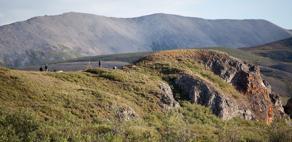Paleoindian Adaptations in Eastern Beringia: Prelude or Postscript to the Early Settlement of the Americas?

In partnership with the Bureau of Land Management and with funding from the National
Science Foundation (Award No. 1111395), department staff will conduct archaeological
investigations at the late Pleistocene age Raven Bluff site in interior northwestern
Alaska. Fluted projectile points are widespread throughout the Americas and are associated
with the earliest phase of human occupation in most regions, but they have not been
reliably dated in eastern Beringia (Alaska and unglaciated portions of Yukon), a region
that plays a central role in models of New World colonization. As a result the Beringian
fluted points have yet to be situated in a historical or ecological context, and there
is little known about the behavior of the people who used this technology and their
relationship to fluted point users in the midcontinent. Raven Bluff has potential
to help address these questions, not only because it contains a fluted projectile
point component in a stratified context, but also a well-preserved faunal assemblage,
which is a first for an ice age site in arctic Alaska.
The goal of the research is to develop datasets relevant to these issues from excavations
at Raven Bluff and from new analyses of existing fluted point assemblages found in
museum collections and published literature. Specific objectives include: (1) establishing
a chronological and stratigraphic framework for the archaeological deposits; (2) reconstructing
the late Pleistocene and early Holocene environmental setting using faunal, botanical,
pedological and sedimentological data and associating these data with patterns of
human resource exploitation and land use; (3) describing strategies of faunal exploitation
evident at the site and generating hypotheses about the nature of the subsistence
economy; and (4) characterizing the stone tool production and maintenance activities
conducted at the site, including methods of fluted point manufacture and repair. Building
on insights from our detailed studies at Raven Bluff we also plan to reexamine most
of the known fluted point assemblages from Alaska, as well as published data from
selected fluted point assemblages from the midcontinent, in order to evaluate hypotheses
about the transmission and development of fluted point technology within Beringia,
and its transmission between Beringia and the midcontinent.
Insights resulting from this work will help resolve longstanding questions about the
timing of the fluted point occupation in Beringia, and the subsistence and technological
adaptations of the people who made fluted points in an extreme, high latitude environment.
It will also fill a major geographic and temporal gap in our knowledge of Paleoindian
dispersals throughout the Americas. These issues are important because they are connected
to the general process of first entry and adaptive radiation of people in any part
of the world, and shed light on the means by which small scale societies adapt to
diverse environmental challenges.
